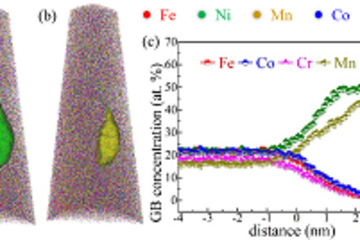All genres
2121.
Poster
Increased detector efficiency helps to reveal new insights into compositional fluctuations at defects in Cu2ZnSnSe4 thin films. E-MRS Spring Meeting 2018, Strasbourg, France (2018)
2122.
Poster
Correlative atom probe tomography and in-situ scanning photoemission electron microscopy applied to catalytically active materials. Atom Probe Tomography and Microscopy 2018, Gaitherburg, MD, USA (2018)
2123.
Poster
Innovative Metallurgical Design Strategies Tailored to Additive Manufacturing. MRS spring meeting, Phoenix, AZ, USA (2018)
2124.
Poster
Physical Metallurgy of Segregation and Austenite Reversion in Medium Mn Steels. TMS 2018 Annual Meeting & Exhibition, Phoenix, AZ, USA (2018)
2125.
Poster
Ab initio assisted design of quinary dual-phase high-entropy alloys with transformation-induced plasticity. TMS 2018, Phoenix, AZ, USA (2018)
2126.
Poster
Increased detector efficiency helps to reveal new insights into compositional fluctuations at defects in Cu2ZnSnSe4 thin films. APT&M 2018, NIST, Gaithersburg, MD, USA (2018)
2127.
Poster
Hot Deformation of low alloy steels. Meeting Materials 2017, M2i Conference, Noordwijkerhout, The Netherlands (2017)
2128.
Poster
Precipitation kinetics during non-linear heat treatment in Laser Additive Manufacturing. International Conference on Advanced Materials and Processes, ‘ADMAT 2017’ SkyMat, Thiruvananthapuram, India (2017)
2129.
Poster
The effect of size-independent strength on the size effect in micro-compression tests. MRS Fall Meeting, Boston, MA, USA (2017)
2130.
Poster
Development of high temperature Mo–Si–B based alloy through Laser Additive Manufacturing. Intermetallics 2017, Bad Staffelstein, Germany (2017)
2131.
Poster
Getting insights to Alzheimer‘s disease by atom probe tomography. 7th European Atom Probe Workshop, Gullmarsstrand, Sweden (2017)
2132.
Poster
Precipitation kinetics during non-linear heat treatment in Laser Additive Manufacturing (LAM). Alloys for Additive Manufacturing Symposium, Zürich, Switzerland (2017)
2133.
Poster
Designing a novel Fe–Ni–Al Maraging steel for Laser Metal Deposition exploiting Intrinsic Heat Treatment. EUROMAT 2017 Conference, Thessaloniki, Greece (2017)
2134.
Poster
Designing a novel Fe–Ni–Al Maraging steel optimised for Laser Metal Deposition. Alloys for Additive Manufacturing Symposium, Zürich, Switzerland (2017)
2135.
Poster
Getting insights to Alzheimer‘s disease by atom probe tomography. 6th International caesar conference, Overcoming Barriers — atomic-resolution and beyond: advances in molecular electron microscopy, Bonn, Germany (2017)
2136.
Poster
Unravelling the identity of (Cu1+,Cu2+)xOy surface oxides formed under ethylene epoxidation conditions on AgCu catalysts. 1st IMPRS – RECHARGE SCIENTIFIC SYMPOSIUM 2017, University Duisburg-Essen, Essen, Germany (2017)
2137.
Poster
Methodology for High Resolution Direct Study of Grain Boundary Diffusion, Segregation and Precipitation. Microscopy and Microanalysis 2017 Conference, St. Louis, MO, USA (2017)
2138.
Poster
Experimental-Numerical Analysis of Primary Recrystallization in DC04 Low Carbon Steel. Gordon Research Conference on Physical Metallurgy: Frontiers of Quantification and Predictive Capability in Physical Metallurgy, University of New England, Biddeford, ME, USA (2017)
2139.
Poster
Physical Metallurgy of segregation, austenite reversion, carbide precipitation and related phenomena in medium Mn steels. Gordon Research Conference: Physical Metallurgy, Biddeford, ME, USA (2017)
2140.
Poster
Quasi In-Situ Untersuchung der statischen Rekristallisation in DC04 Stahl. Fachtagung für Mikroskopie und Präparation MikPräp 2017, Solingen, Germany (2017)











